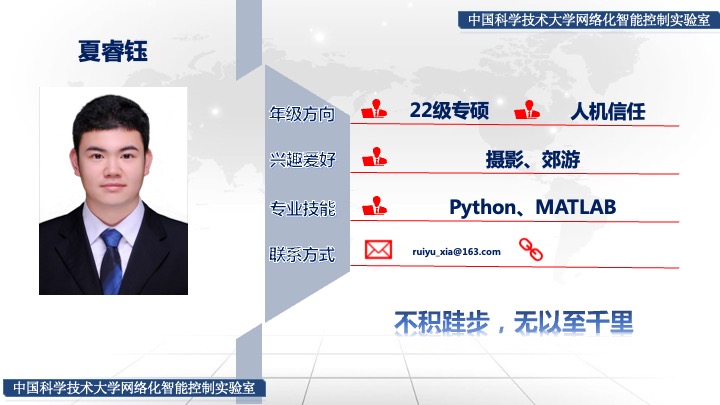个人信息

参与实验室科研项目
人机混合智能系统双层智能测试评估技术研究
复杂环境下非完全信息博弈决策的智能基础模型研究
机载座舱智能系统人机信任动态演化建模方法研究
研究课题
面向信任的人机协同搜救方法研究
学术成果
共撰写/参与撰写专利 1 项,录用/发表论文 2 篇,投出待录用论文1篇。 联培学生可能有其他不在此展示的论文/专利。
patent
-
眼科病人信息录入软件V1.0
康宇,
田霞,
董凯,
鲁理,
夏睿钰,
赵云波,
刘斌琨,
and 李晓蒙
2023
[pdf]
Book Chapters
-
Trust-Modulated Authority Allocation in Human-Guided Goal Recognition Tasks
Ruiyu Xia,
Yunbo Zhao,
Junsen Lu,
Yang Wang,
Pengfei Li,
and Yu Kang
In Frontiers in Artificial Intelligence and Applications
2025
[Abs]
[doi]
[pdf]
In shared control teleoperation, the machine infers the humans’ goal to provide effective assistance, which we call human-guided goal recognition. However, current methods mainly use algorithm confidence to assign control authority during the process, which makes it difficult to correct machine inference errors under high confidence. To address this problem, we propose a trust model that considers machine capability fluctuations and human-machine interaction experience. We also add trust as a dynamic assessment of machine capabilities to authority allocation to improve the success rate of the tasks. Finally, we verify the effectiveness of the proposed method through experiments.
Conference Articles
-
A Novel Haptic Takeover Method Based on Human-Machine Collaboration States
Yunbo Zhao,
Zuhao Xie,
Chang Xu,
Xiuhua Liang,
Ruiyu Xia,
and Jiayu Li
In 2024 14th Asian Control Conference (ASCC)
2024
[Abs]
[pdf]
The current stage of autonomous driving calls for drivers to remain actively engaged within the control loop in anticipation of the need for takeover operations. However, regaining control of the vehicle from a state of low situation awareness (SA) poses a challenge. To address this issue, this research introduces a novel takeover method based on haptic shared control, ensuring a smooth and safe takeover process. A symmetric softmax function is formulated to evaluate muscle state, taking into account the varying torque thresholds associated with different vehicle speeds, as well as utilizing the driver’s cognitive state to characterize their SA. Within the takeover process, a coordinator leverages the driver’s SA and human-machine intention similarity to determine the current state of human-machine collaboration. Subsequently, different control allocation strategies are then adopted for different states, and the driver is guided through force feedback. Experiment results demonstrate the effectiveness of the proposed method, showcasing its ability to facilitate a smooth and safe transfer of control, regardless of the presence of conflicts or the harmonious state existing between the human driver and the automated system.
博客文章

